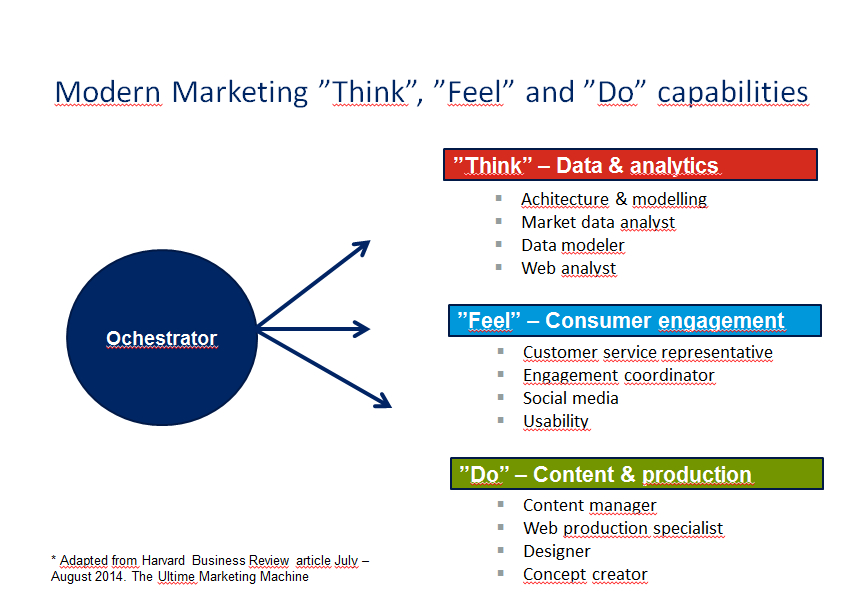Successful Digitalization Requires: Clear Vision and Road Map, Agile Governance, Renewing Processes, New Competences and Data Orientation
Digitalization of sales and marketing should be long term investment and strategic choice in order to win over your competitors service offering and sales efficiency. It is not enough to have only a good road-map or skillful personnel, but all of the digitization elements must be in place.
Many times digitalization initiatives are not able to deliver their full potential as there is too narrow minded approach to digitization. It is not enough to have a good will and some kind of commitment from the management. Here are couple of steps that should be taken in order to start successful digitization journey.
| PAST | FUTURE | |
| Corporate vision | No role in digitization
|
Part of corporate strategy
|
| Digital road map | Separate point solutions
|
One corporate road map
|
| Competences | Marketing:
Sales:
|
Marketing:
Sales:
|
| Customer processes | Manual processes
|
Automated and digital
|
| Data | No integration between different data sources: Financial, CRM, logistics, social, web | Integrated data view to customers enable:
|
| Governance | “Ad hoc” digital execution
|
Clear digital owner and team
|
Elements of Successful Sales and Marketing Digitization. (© 2014 Kimmo Kanerva)
Clear Vision and Road Map Guide Digital Execution
Normally a lot of good digital initiatives are on-going in different divisions and teams. Everyone believes their own doing will benefit their own business area the most. But, many times this is just sub-optimizing execution and the impact. If companies would analyse what will benefit them most across different divisions and geographical areas, it might give totally different view. It would lead to a better result compared to approach that let the thousand blooms blossom.
This is extremely difficult for top management to understand as in 99% of the business decisions it is better to give divisions sufficient independence and autonomy. In this respect digitalization is making exception. It is almost always better to have prioritized company wide road map and visions, in order to allocate scares resources effectively.
90% is about Improving Processes – 10% about Tools
I believe 90% of the digitization efforts should go to improving and changing customer processes. Only 10% of the time and resources should be allocated in creating digital tools.
Renewing processes is the hardest part of digitization as it will have fundamental effect how work is performed. For example, if you start new projects like qualification of leads, predictive analytics or eCare, it will be easy to implement digital tool, but much harder to change how work is performed.
Mind shift from internally focused process improvements should be changed towards thinking what will benefit our customers and how customers would expect the service to be run.
Management needs to be 100% committed in executing process improvements and taking into use digital tools. It is not sufficient to have positive attitude towards process changes, but management needs to steer process improvements. If vigorous change management is not tight into making things happen, it will be impossible to achieve benefits of digitalization.
New Data Driven and Digital Competences are Needed
10 years ago it was sufficient for marketing to master events, make nice looking brochures and look after brand visuals. Those basic marketing skills are still needed but new requirements have emerged.
Today’s marketing is becoming increasingly data driven and personalized. Marketing departments need to master complex lead management, scoring and nurturing programs that feed customers with relevant messages all the way customer life cycle journey. Marketing has become IT and technology driven.
Big Data opportunities are entering into the sales. It is no longer sufficient to be a lonely rider hunting new leads and reporting progress of deals to the CRM system. Different sources of data needs to be integrated e.g. financial, CRM, and web analytics in order to provide guidance where sales personnel should focus sales efforts.
Sales departments need sophisticated and in-depth analysis of customers in order to have consultative and value added discussions. Advanced sales analytics will provide new ways to identify leads from external sources. Matched all the above information with social selling tactics provides prerequisite for new competences and tools for sales.
Simple and Effective Governance
If the digital vision and road map are approved by the top management then the execution will be much smoother and agile. Too many times you hear about long approval processes and decision making bodies.
Daily execution should not require too many approval meetings, but more one to one discussions with subject matter experts or management. Responsible person heading digitization should work very closely with the sales department, a customer service team and customers. The digital leader should have budgets and decision making authority to make agile and constant improvements.
In best case Chief Digital Officer would be reporting directly to CEO. Especially, in order to drive cross divisional process changes, will require deep commitment and involvement from CEO.
Even there is a clear path for digitization that apply to almost all big companies, it is amazing hard to move initiatives forward. A great deal of will to win management support and persistence is needed. However those persons that are willing to put that extra mile, will start to see great results and happy faces from sales.
See Slideshare: Seminar presentation in Stockholm about Digitalization of Sales and Marketing October 17, 2014

